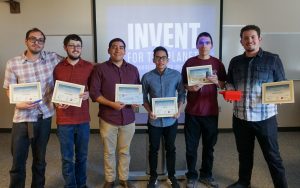WRITER: Vladimir Avina, 575-646-7234,
vlad23@nmsu.eduCONTACT: Kelsey Hayes, Innovate@nmsu.edu
Microplastics polluting the Pacific Ocean could be cleaned up and recycled with the help of an invention created by Crustacean, a design team at New Mexico State University.
 |
| NMSU’s Crustacean design team has been invited to attend the final judging competition of Invent For The Planet 2020 at Texas A&M University. L-R Evan Hughes, Taw Trobaugh, Roberto Holguin, Erik Le, Brian Evan Saunders, and Richard Cazares. (NMSU Photo by Vladimir Avina) |
Competing against 40 universities worldwide, Crustacean is one of six finalists in the 48-hour Invent for The Planet (IFTP) design competition hosted by Texas A&M University. Before being selected as one of the finalists, Crustacean competed at NMSU against three local teams.
This is the first time in the three years of IFTP in which a team from NMSU has been invited to the final competition. The team consists of graduate mechanical engineering students Brian Evan Saunders and Erik Le, undergraduate mechanical engineering students Roberto Holguin, Richard Cazares, Taw Trobaugh and journalism student Evan Hughes.
Crustacean’s invention is a cylinder-shaped device locked to an ocean buoy. It would be used to clean the Great Pacific garbage patch, a milky plastic island between the West Coast of North America and Japan. The plastic would be separated from other pieces of trash and recycled. Business Insider reports there are companies like Adidas that are already using recycled plastic from the ocean to make shoes.
“We figured the most ambitious but feasible project was probably cleaning up ocean microplastics,” Holguin said. “It’s an issue all of us cared about and have a genuine interest in trying to solve that problem.”
On Valentine’s Day, four teams met at the College of Engineering Aggie Innovation Space (AIS) to start the 48-hour competition. Saunders said one of the challenges Crustacean faced was designing something unique that was not already published online.
“Initial designs included a washing machine filter and a pump powered filter bin, both of which already exist,” Saunders said.
Aside from designing a product, teams have to calculate the cost of production, develop a presentation with a video for their pitch and create prototypes of their invention. On Sunday, Feb. 16, all four NMSU teams pitched their inventions to a panel of local judges. After the top three finalists were announced, the winning team then had a week to tailor their product and presentation.
Inventions from other teams include an automated drone system used for wildfires, automated traffic lights and ecofriendly power cells that produce electricity through chemical reactions.
“Design challenges such as IFTP are great resume boosters, perfect experiences to discuss in interviews, opportunities to communicate with students, faculty, and company representatives from all over the world,” said Kelsey Hayes, chemical and materials engineering student and lead Innovator at the AIS.
Hayes was the organizer for NMSU’s IFTP competition. She coordinated with faculty, staff and innovators to organize work schedules, video recordings and mentorship for the teams.
“I think the hardest part about having the AIS host IFTP 2020 was coordinating supplies and appropriate resources for four teams that spend an entire weekend at this competition,” Hayes said. “From food and materials, to access to computer programs, it was a lot more complicated trying to help 26 students succeed in their projects as compared to five last year.”
This is the third year the College of Engineering hosted IFTP and the second year AIS coordinated the competition.
Hayes said the AIS could continue hosting competitions like IFTP but needs sponsors and mentors.
“If we hope to continue to grow this event, I think we will definitely be looking for sponsors who are not only willing to give food or supplies but possibly their time as mentors to help the students develop their projects in areas where us as innovators may not be able to, as we are also just students ourselves,” Hayes said. “As the AIS is a student resource center, we work to provide material and educational resources to students across campus and hosting IFTP is one way that we successfully do that.”
Crustacean will travel to the Texas A&M campus in College Station, Texas, in July. The final IFTP judging competition was set for March 31 through April 2 but was postponed due to concern for students’ health from the COVID-19 coronavirus outbreak.
“After working on this for as long as we have, I’m expecting to ‘wow’ the judges at Texas A&M,” Cazares said. “I really think we have a chance of winning this and ultimately making our project a reality.”
